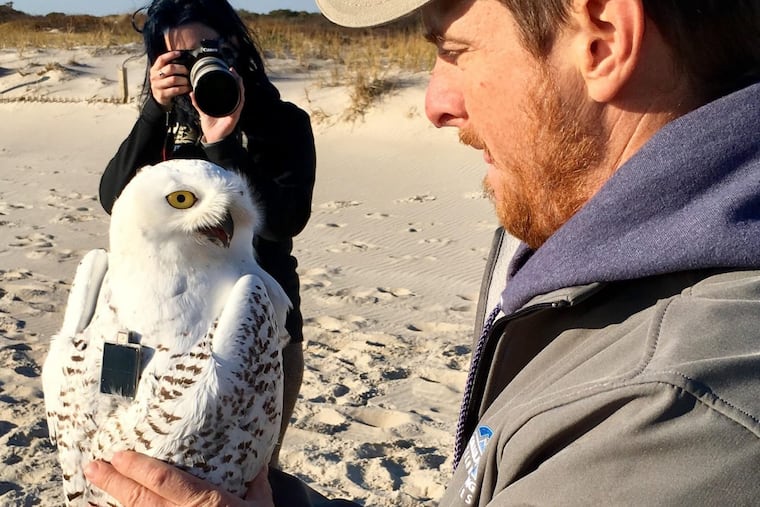Snowy owls flock to New Jersey and Pennsylvania
Most years, New Jersey gets one of these Arctic birds, or none at all. So far this year, as many as 10 have been spotted.

Snowy owls, the Arctic creatures beloved by birders and Harry Potter fans alike, are back.
Four years after hundreds of the majestic birds flew south to Pennsylvania and New Jersey for the winter, they been spotted here in significant numbers once again.
Normally they are confined to the northern reaches of the United States during the winter, but this fall a few of the striking white birds have been seen as far south as Virginia and North Carolina.
In New Jersey, the total number of "snowies" reported in the past few weeks alone is approaching 10. An entire winter often yields one or zero, said David La Puma, director of New Jersey Audubon's Cape May Bird Observatory. And conditions suggest the total for the coming months could grow much higher, he said.
The reasons behind that prediction take a bit of explaining, involving the population of lemmings — the small rodents they feast on — in Canada. And some of the underlying science remains a mystery. But as with so many things in life, the answers seem to involve sex and food.
Seeking to learn more, conservationists caught two snowy owls Wednesday at Island Beach State Park and fitted them with lightweight wireless tracking devices, part of a national effort by Project SNOWstorm, a national volunteer group.
The pair were named Islandbeach (all one word, to make it easier on the computer program that captures the bird data) and Lenape. This is science, so no cute humanizing nicknames, and certainly no use of the name Hedwig, the snowy owl of the Harry Potter books.
Seeing them up close was a thrill, said Mike Lanzone, president and chief executive officer of Cellular Tracking Technologies, a Rio Grande, N.J., company that made the wireless tracking devices.
"The big yellow eyes on the white bird, it is just a pretty awesome-looking creature," he said.
A research biologist by training, Lanzone set net-like traps to capture the birds and also fitted them with the wireless trackers, as he has the required permits from state and federal authorities.
Joining him were La Puma and his colleague Erin Rawls. The group lured each bird to the trap by using a pigeon as bait. Then, very gently, they took feather samples for later chemical testing that could reveal where the animal was born, and blood samples to test for levels of toxic pollutants such as mercury and lead. Both birds also were measured. The whole process took less than an hour, then they were set aloft once again.
The rise and fall of snowy owl populations in various locations is tied to numbers of lemmings, said Scott Weidensaul, a naturalist, author, and co-founder of Project SNOWstorm.
"The birds tend to move around the Arctic and sub-Arctic and nest wherever the lemming population has reached its peak," Weidensaul said.
In the fall and winter of 2013-2014, the last time snowy owls came south in force, wildlife surveys detected record numbers of nests on the Ungava peninsula, in northern Quebec.
Once again this year, surveys found lots of nests on the same peninsula, possibly explaining why the young are now showing up again in the mid-Atlantic. The more young birds born at nesting sites, the farther afield they fly in the winter to find food, said La Puma, of the bird observatory.
"There's too many kids in the kitchen," he said.
The birds that come here tend to be younger ones, as they are lower on the social hierarchy and get "pushed" farther south, Weidensaul said. The same generally holds true for males, which are less socially dominant than females, he said.
Upon arrival, the birds look for places that resemble their northern home, where there is little tree cover. That means coastlines, such as the Jersey shore, farmland, and unfortunately airports.
"Sadly, they really love airports," Weidensaul said.
Birds have died in collisions with planes, and can be risky for the plane as well, which is why Philadelphia International Airport and others have worked with conservationists to track and relocate birds, when possible.
The wireless trackers are sophisticated pieces of equipment, weighing just an ounce or two and powered by miniature solar panels. The ones used on the owls are a special version of the "Featherlight" model from Lanzone's company — a $3,000 base unit plus $1,500 worth of added custom features, he said. The company provides them at a reduced price to the conservation project, and also has donated some outright along with the associated wireless fees, Lanzone said.
Project SNOWstorm buys the trackers with funds from donors. Several dozen birds have been fitted with the devices since the project began in 2013. The flight patterns of some of the birds can be seen on the group's website.
Though this is a research project, Weidensaul concedes that the bird has star quality, which does not hurt the group's fundraising efforts. Appeals for the hapless vulture, the carcass-feeding bird that is at risk in many parts of the world, does not have nearly the same draw, Weidensaul said.
"The fact that we're dealing with this big, charismatic, sexy bird makes all the difference," he said.